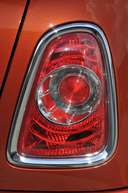2011 Mini Cooper D Convertible Review First Drive
 2011 MINI Convertible |
Mini gets facelift and new diesel engines
By Henny Hemmes
Senior European Editor
Amsterdam Bureau
The Auto Channnel
MUNICH, August 3, 2010. Since the market launch of the new Mini, the brand has set many records and is on its way to set a new one. Last month, when we drove the Mini Countryman for the first time, it became clear that Mini is heading towards the sale of 300,000 unites per year. May be not as early as next year, but at least soon after. In 2009 Mini sold 215,000 cars and in the first half of this year 109,000 Mini’s were sold worldwide, an increase of 7.7. per cent compared to the first half of last year.
Recently, the production capacity of the plant in Oxford, UK, has been raised to 260,000 units. Together with the production capacity of 40,000 units of the Magna Steyr plan in Graz, Austria, where the Countryman is built, the total capacity will be 300,000..
In the meantime, Mini has to work hard to maintain its top position in the premium mini -egment, with new comers on the brink, such as the CitroŽn DS3, a French Mini copy. Or the Audi A1, that may not provide the same fun, but will attract premium buyers.
Just in time, Mini comes up with a face lift of the three models that have been on the market so far, the One, the Cabrio and the Clubman. Yesterday, I was one of the first to get behind the wheel of one of the rejuvenated models, the Cooper D Convertible.
This engine variant is the new 4-cylinder BMW 1.6-liter diesel engine that replaces the one that has been developed together with PSA. It is a tweaked variant of the 2.0-liter self burners in the BMW 116d and 118 d, so it fits under the small Mini hood in east-west direction.
Fuel Sipping
 |
More important, though, is the fuel efficiency that improves to 3.8 l/km(74.3 mpg) in the combined European cycle. With a CO2-emission of only 99 g/km, you do not have to pay road tax in several European countries, like my own, the Netherlands. How fun can fuel sipping be..?
This diesel engine and the normally aspirated version with 66 kW/90 hp (and the same fuel efficiency and emission) will be available in the Mini One, the Cabrio and the Clubman.
True to its roots
 |
The six speed manual transmission matches the engine well and shifting is easy and quick. With the rev band of 1750 to 2250 for maximum torque, you may also be enjoying the route and be a bit lazy, meaning keeping the transmission in fourth gear and still be able to step on the gas and go for a quick passage on a two lane road. I checked the acceleration from 80-120 km/h at the chronograph on my wrist, reading 7 seconds in third gear.
 |
Mini first: Web radio
It is lovely to be able to drive in the open air, and a few sprinkles would
not hurt the interior of the Mini Convertible, but when big rain drops
started to come down, the top went up. Upon returning to Mini’s base
for the event, the BMW facility at Garching, it is time to park the car and
have electronics engineer JŁrgen Woryna explain the functionality of Mini
Connected.
 |
As prices for the US have not been announced yet, so we do not know about the options either.
 |
Furthermore, the Dynamic Music function is implicated in the system. It is a selection of specially composed music that you can play on the audio and of which the rhythm and dynamics change according to your driving style. It allows a driver to use the accelerator and steering wheel to create a sound track matching the go-kart feeling of the car. In the near future, you should not be surprised to see Mini driver in normal traffic wearing a helmet…!
Recognizable
 |
 |
The refreshed 2011 models seem to be right in time, since the premium mini-segment gets some new players that will try to rival the iconic modern Mini. But those cars lack the support and loyalty of a huge group of super enthusiast followers world wide. Add to this the face lift, fuel efficient engines and Connected Drive possibilities, and you can see that Mini is three steps ahead of the competition.
On September 18, the renewed 2011 Mini will hit markets world wide. North-America will get it in January.


